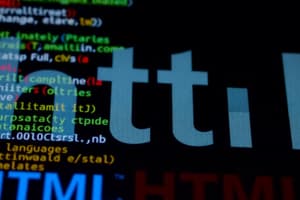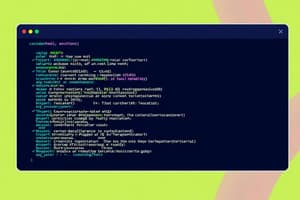Podcast
Questions and Answers
Which statement best describes the primary function of a web browser in the context of HTML?
Which statement best describes the primary function of a web browser in the context of HTML?
- To encrypt HTML documents for secure transmission over the internet.
- To write and edit HTML documents using a text editor.
- To compile HTML code into executable programs.
- To read HTML documents and display them correctly to the user. (correct)
How does a web browser utilize HTML tags when displaying a webpage?
How does a web browser utilize HTML tags when displaying a webpage?
- It ignores the HTML tags and only displays the content.
- It uses the HTML tags to determine how to format and display the content, but does not show the tags themselves. (correct)
- It translates HTML tags into a different programming language for display.
- It displays the HTML tags alongside the content, allowing users to see the underlying structure.
What is the role of the <html> element in an HTML document?
What is the role of the <html> element in an HTML document?
- It defines the main content of the HTML document.
- It contains metadata about the HTML document, such as character set and viewport settings.
- It serves as the root element that contains all other elements in the document. (correct)
- It specifies the title of the HTML document.
What is the primary purpose of the <title> element in an HTML document?
What is the primary purpose of the <title> element in an HTML document?
What is the correct syntax to display the copyright symbol in HTML?
What is the correct syntax to display the copyright symbol in HTML?
Which of the following statements is true regarding the <DOCTYPE html> declaration?
Which of the following statements is true regarding the <DOCTYPE html> declaration?
In HTML, what constitutes an element?
In HTML, what constitutes an element?
What are 'empty elements' in HTML?
What are 'empty elements' in HTML?
What does it mean for HTML elements to be 'nested'?
What does it mean for HTML elements to be 'nested'?
Which of the following represents the correct nesting order of basic HTML elements?
Which of the following represents the correct nesting order of basic HTML elements?
What is a primary characteristic of HTML attributes?
What is a primary characteristic of HTML attributes?
In the context of HTML, what does the href attribute in the <a> tag specify?
In the context of HTML, what does the href attribute in the <a> tag specify?
What is the key difference between block-level and inline elements in HTML?
What is the key difference between block-level and inline elements in HTML?
Which of the following HTML elements is commonly used as a block-level element to create divisions or sections in a web page?
Which of the following HTML elements is commonly used as a block-level element to create divisions or sections in a web page?
What is the purpose of the <h1> to <h6> tags in HTML?
What is the purpose of the <h1> to <h6> tags in HTML?
Which HTML tag is used to define a paragraph?
Which HTML tag is used to define a paragraph?
Which HTML element is used to define a quotation?
Which HTML element is used to define a quotation?
Which of the following is the correct way to create a link that sends an email using HTML?
Which of the following is the correct way to create a link that sends an email using HTML?
What is the purpose of the HTML phrase elements like <strong> and <em>?
What is the purpose of the HTML phrase elements like <strong> and <em>?
Which HTML tag is used to define a description list?
Which HTML tag is used to define a description list?
A web browser's primary function is to render HTML documents correctly.
A web browser's primary function is to render HTML documents correctly.
HTML tags are directly displayed by the browser to show the structure of the document.
HTML tags are directly displayed by the browser to show the structure of the document.
The <body> section's content in an HTML document is viewable to users in the browser window.
The <body> section's content in an HTML document is viewable to users in the browser window.
The <title> element's content appears in the browser's main content area.
The <title> element's content appears in the browser's main content area.
In HTML, © is the correct code to display the copyright symbol.
In HTML, © is the correct code to display the copyright symbol.
HTML documents must start with the declaration <!DOCTYPE xml>.
HTML documents must start with the declaration <!DOCTYPE xml>.
An HTML element is defined only by a start tag.
An HTML element is defined only by a start tag.
All HTML elements must be nested within a parent element.
All HTML elements must be nested within a parent element.
The <html> element does not require a closing tag.
The <html> element does not require a closing tag.
Attributes in HTML always appear in the closing tag of an element.
Attributes in HTML always appear in the closing tag of an element.
The href attribute in an <a> tag specifies the URL that the link points to.
The href attribute in an <a> tag specifies the URL that the link points to.
Block-level elements, like <p>, are displayed inline by default.
Block-level elements, like <p>, are displayed inline by default.
Inline elements, like <span>, always start on a new line.
Inline elements, like <span>, always start on a new line.
In HTML, <h1> elements are less important than the <h6> elements.
In HTML, <h1> elements are less important than the <h6> elements.
The <p> tag is used to define paragraphs in HTML.
The <p> tag is used to define paragraphs in HTML.
The <blockquote> element is used to show short quotes.
The <blockquote> element is used to show short quotes.
HTML links cannot be used to create clickable phone numbers.
HTML links cannot be used to create clickable phone numbers.
The <br> element is used to create a new paragraph.
The <br> element is used to create a new paragraph.
In HTML, <em> tag is specifically for bold text.
In HTML, <em> tag is specifically for bold text.
In HTML tables, the <th> tag can be used to define both row and column headers.
In HTML tables, the <th> tag can be used to define both row and column headers.
Flashcards
What is HTML?
What is HTML?
HTML stands for Hyper Text Markup Language. It is the standard markup language for creating Web pages, describes the structure of a Web page, consists of a series of elements.
Web browser purpose?
Web browser purpose?
Web browsers (Chrome, Edge, Firefox, Safari) read HTML documents and display them correctly. They don't show HTML tags but use them.
HTML document structure
HTML document structure
All HTML documents must start with a document type declaration: <!DOCTYPE html>. The HTML document itself begins with <html> and ends with </html>. The visible part is in <body>.
What defines an HTML element?
What defines an HTML element?
Signup and view all the flashcards
Nesting in HTML elements
Nesting in HTML elements
Signup and view all the flashcards
HTML attributes
HTML attributes
Signup and view all the flashcards
Common HTML tag attributes
Common HTML tag attributes
Signup and view all the flashcards
Block vs. Inline?
Block vs. Inline?
Signup and view all the flashcards
Block-level elements
Block-level elements
Signup and view all the flashcards
Inline Elements
Inline Elements
Signup and view all the flashcards
What are HTML Headings?
What are HTML Headings?
Signup and view all the flashcards
HTML Paragraphs
HTML Paragraphs
Signup and view all the flashcards
HTML Blockquotes
HTML Blockquotes
Signup and view all the flashcards
Signup and view all the flashcards
Absolute vs. Relative Links
Absolute vs. Relative Links
Signup and view all the flashcards
Types of HTML lists
Types of HTML lists
Signup and view all the flashcards
element in HTML documents?
Signup and view all the flashcards
Signup and view all the flashcards
Basic HTML table tags
Basic HTML table tags
Signup and view all the flashcards
What is th element?
What is th element?
Signup and view all the flashcards
Colspan and Rowspan?
Colspan and Rowspan?
Signup and view all the flashcards
Special Entity Characters
Special Entity Characters
Signup and view all the flashcards
mailto: links
mailto: links
Signup and view all the flashcards
tel: links
tel: links
Signup and view all the flashcards
tag
tag
Signup and view all the flashcards
tag
tag
Signup and view all the flashcards
HTML Phrase Elements
HTML Phrase Elements
Signup and view all the flashcards
tag
tag
Signup and view all the flashcards
tag
tag
Signup and view all the flashcards
element
Signup and view all the flashcards
Signup and view all the flashcards
element
Signup and view all the flashcards
Signup and view all the flashcards
Enhanced table elements
Enhanced table elements
Signup and view all the flashcards
tag in tables
Signup and view all the flashcards
Study Notes
- HTML stands for Hyper Text Markup Language.
- HTML is the standard markup language for creating Web pages, describing the structure of a Web page.
- HTML consists of a series of elements.
- HTML elements instruct the browser on how to display content.
- HTML elements label content, such as "this is a heading", "this is a paragraph", and "this is a link".
Simple HTML Document Structure
<!DOCTYPE html>declares the document type as HTML.<html>element is the root element of an HTML page.<head>element contains meta-information about the HTML page.<title>element specifies a title for the HTML page, which is shown in a browser's title bar or tab.<body>element contains the visible page content.<h1>element defines a large heading.<p>element defines a paragraph.
Web Browsers
- Web browsers like Chrome, Edge, Firefox, and Safari read HTML documents and display them correctly.
- Browsers do not show the HTML tags, but use them to determine how to display the content.
- The content inside the
<body>section appears in the browser. - The content inside the
<title>element appears in the browser's title bar or page tab.
Special Entity Characters
- Special characters such as quotes and copyright symbols can be inserted.
- Use
©for the copyright symbol. - Use
<for the less than symbol (<). - Use
>for the greater than symbol (>). - Use
&for the ampersand (&). - Use
for a space.
HTML Documents
- Documents must start with a
<!DOCTYPE html>declaration. - The HTML document begins with
<html>and ends with</html>. - The visible content is placed between
<body>and</body>.
HTML Elements
- Defined by a start tag, content, and end tag:
<tagname>Content goes here...</tagname>. - The HTML element includes everything from the start tag to the end tag.
- Some HTML elements have no content and are called empty elements, like
<br>, and do not have an end tag.
Nested HTML Elements
- HTML elements can be nested, meaning one element can contain other elements.
- All HTML documents consist of nested HTML elements.
- A basic HTML structure contains
<html>,<body>,<h1>, and<p>elements. - The
<html>element is the root and defines the whole HTML document. - It has a start tag
<html>and an end tag</html>. - Inside the
<html>element is the<body>.
HTML Attributes
- HTML attributes provide extra information about HTML elements and are specified in the start tag.
- Attributes come in name/value pairs;
name="value". - The
<a>tag defines a hyperlink, with thehrefattribute specifying the link's URL:<a href="https://www.google.com">Visit google</a>. - The
<img>tag should includewidthandheightattributes to define the image dimensions:<img src="img.jpg" width="500" height="600">.
HTML Block and Inline Elements
- Every HTML element has a default display value, dependent on its type.
- Block-level elements start on a new line, and the browser adds some space (margin) before and after:
<p>,<div>. - Inline elements do not start on a new line and only occupy as much width as necessary.
- Commonly used block elements:
<p>defines a paragraph,<div>defines a division or section. - Example of displaying an inline element
<span>inside a paragraph.
HTML Headings
- HTML headings are titles or subtitles displayed on a webpage.
- Headings are defined with
<h1>to<h6>tags. <h1>defines the most important heading, and<h6>defines the least important.
HTML Paragraphs
- HTML paragraphs are defined with the
<p>tag.
HTML Quotations
- The
<blockquote>element defines a section quoted from another source. - Browsers typically indent
<blockquote>elements.
HTML Links
- The
<a>tag creates hyperlinks, allowing users to navigate between pages. Defined with the<a>tag. - Absolute links point to other websites:
<a href="https://yahoo.com">Yahoo</a>. - Relative links point to pages on the same site and relative to the current page:
<a href="index.html">Home</a>. - The
<a>tag can create links for email addresses using themailto:protocol:<a href="mailto:[email protected]">This is a link</a>. - HTML links can create a clickable phone number link using the
tel:protocol:<a href="tel:+97470070070">Call Us</a>triggers the phone dialer on a mobile device.
HTML Line Break Element
- Creates a line break.
<br>is a stand-alone tag. Called a void element in HTML5.- Causes the next element or text to display on a new line.
HTML Horizontal Rule Element
- Horizontal Rule element is a void element
- Configures a horizontal line on the page using the tag
<hr>. - In HTML5, it indicates a thematic break at the paragraph level.
HTML Phrase Elements
- Phrase elements indicate the context and meaning of text and are displayed inline.
<b>tag is for bold text.<strong>tag is for text with strong importance.<i>tag is for italic text.<em>is for emphasized text.
HTML Lists
- HTML lists allow grouping of related items in lists.
- Types of lists: Unordered, Description, and Ordered.
Unordered HTML Lists
- An unordered list starts with the
<ul>tag. - Each list item starts with the
<li>tag. - List items are marked with bullets (small black circles) by default.
Ordered HTML List
- Starts ith the
<ol>tag, with each item starting with the<li>tag. - By default, the list items will be marked with numbers.
HTML Description Lists
- Description lists comprise terms and their descriptions.
<dl>tag defines the description list.<dt>tag defines the term (name).<dd>tag describes each term.
HTML Div Element
- The
<div>element serves as a container for other HTML elements. - It's a block element by default, occupying available width, with line breaks before and after.
- It is able to contain other block display and inline display elements.
- Multiple
<div>containers can be used on the same page.
Structural Elements
- Structural elements organize different sections of a webpage.
<header>for headings.<nav>for main navigation.<main>for main content.<footer>that contains the footer.
HTML Tables
- HTML tables enable arranging data into rows and columns, and this is best suited for logically grouping related items.
- Tables are created with the table tag
<table> </table>: a container for table rows. - Each table row is created with the
<tr> </tr>tag. It provides a container for table data cells, - Each table data cell is created with the
<td> </td>tag,enclosing actual data. - A table title can be specified with
<caption> </caption>tags. - Row and column headings can be added between
<th> </th>tags. If included, the<caption>element must immediately follow the opening<table>tag.
HTML Table Colspan & Rowspan
Colspanis used to make a cell span over multiple columns.- To make a cell span over multiple rows you can use
Rowspan.
Enhanced HTML Tables
- Tables can have special header and footer rows using
<thead>and<tfoot>tags. - Table rows should be enclosed in
<tbody>tags when<thead>and/or<tfoot>are used. - Elements can group rows into sections for long tables.
- When printed, headers and footers can repeat on each page.
<thead>must appear before<tbody>, but after<caption>if present.- This structure enhances table readability and organization.
HTML Validation
- Check code for syntax errors.
- Valid code ensures more consistent browser display.
- Can use the W3C HTML Validation Tool: http://validator.w3.org, http://validator.w3.org/nu
- Use the HTML5 Validation Tool: http://html5.validator.nu
Studying That Suits You
Use AI to generate personalized quizzes and flashcards to suit your learning preferences.




